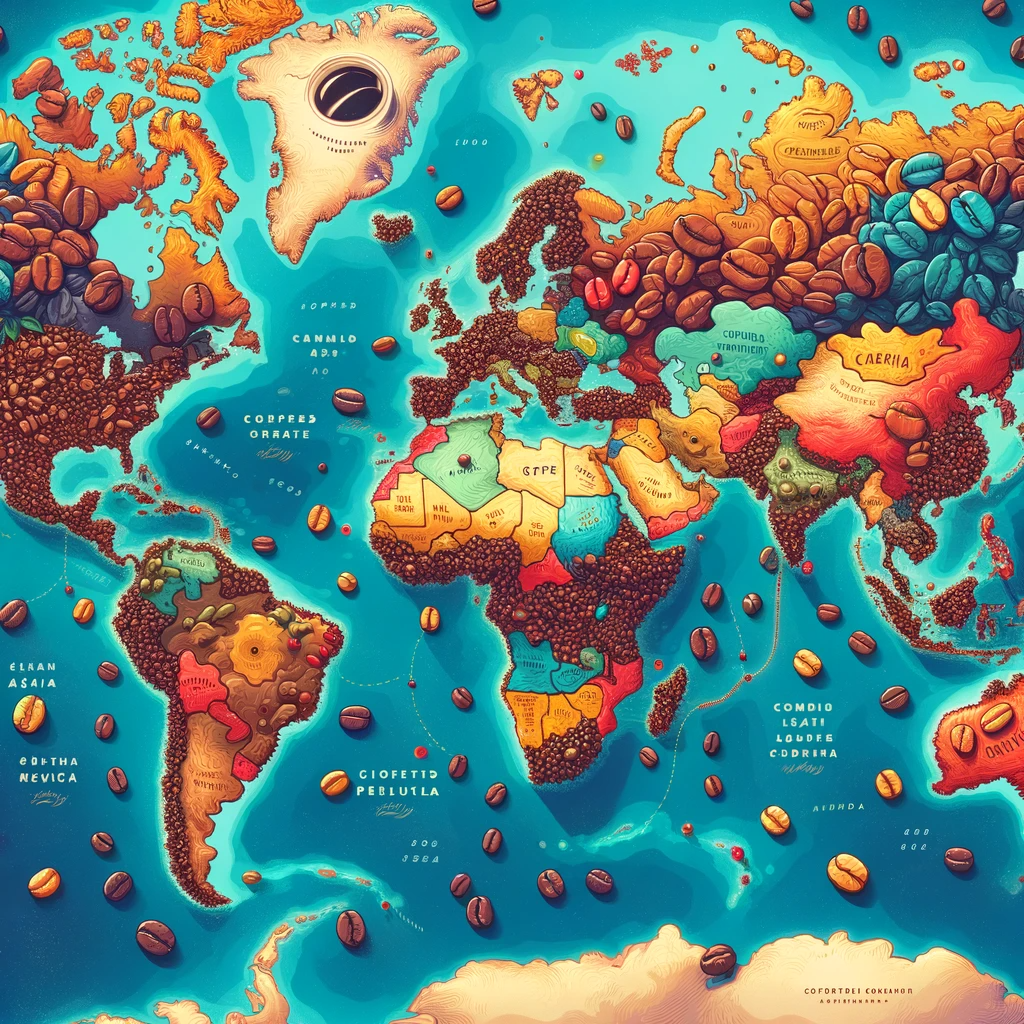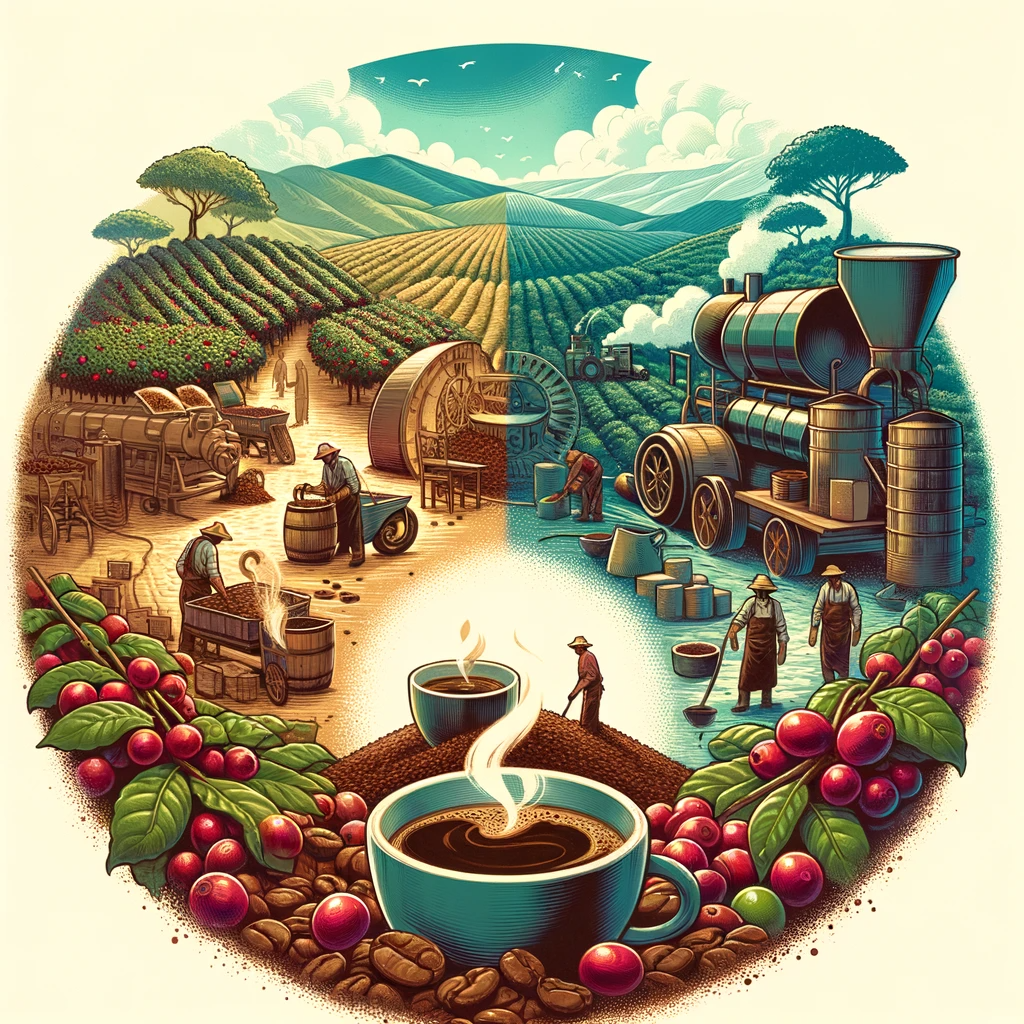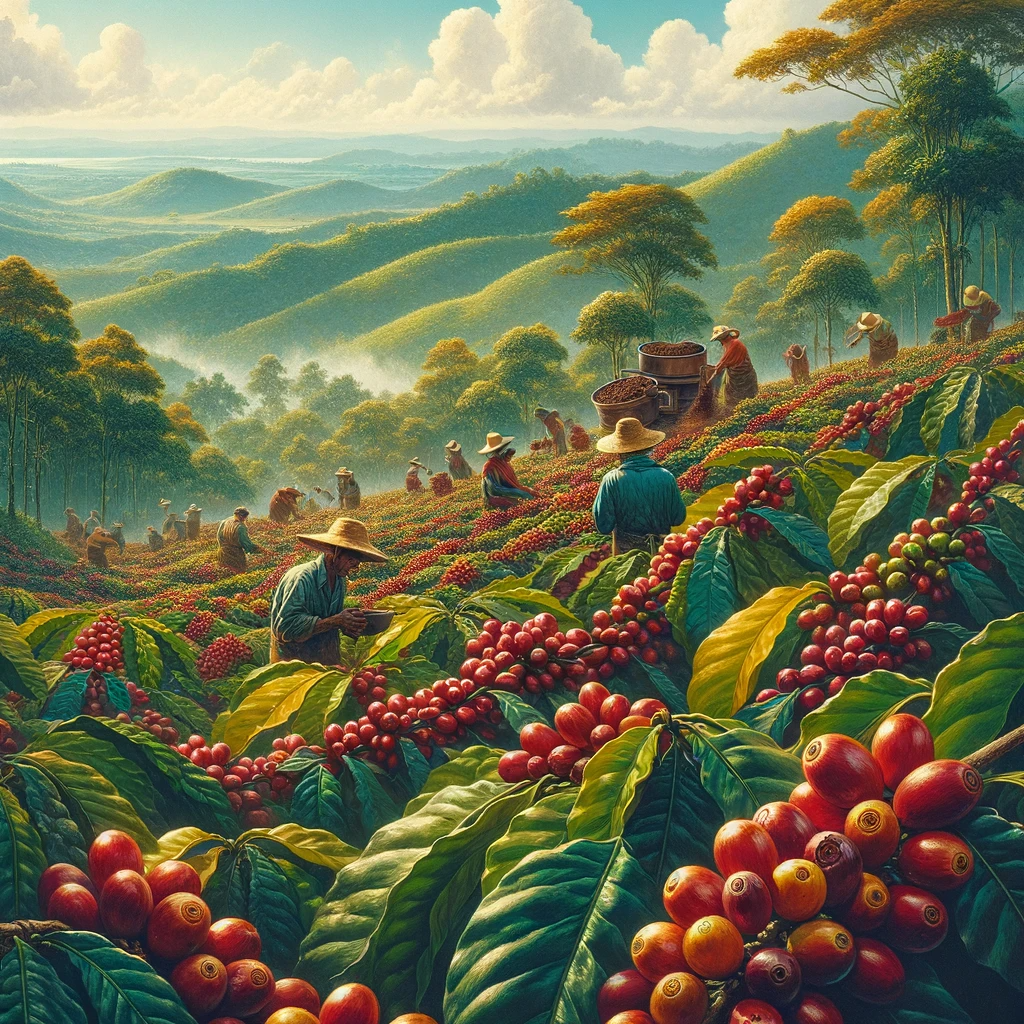Introduction
Coffee is a globally beloved beverage that has become an integral part of many people’s daily routines. Its rich aroma and refreshing taste have made it a staple in households and cafes worldwide. But have you ever wondered where coffee actually comes from? The origins of this beloved beverage can be traced back to ancient times, with Ethiopia being credited as the birthplace of coffee. From there, coffee cultivation spread to other regions, shaping the coffee industry as we know it today. In this article, we will explore the global origins of coffee production, from the African continent to South America, Central America, and Asia. Prepare to embark on a journey through the lands that have contributed to the world’s most popular beverage – coffee.
The Popularity And Global Significance Of Coffee
Coffee has undoubtedly become one of the most popular and beloved beverages worldwide. Its rich, complex flavors and energizing effects have captivated the taste buds of millions of people. From early morning rituals to afternoon pick-me-ups and gatherings with friends, coffee has ingrained itself in our daily lives.
But beyond its enjoyment, coffee holds significant global importance. The coffee industry generates employment and economic opportunities for countless communities around the world. It has shaped entire regions, supporting the livelihoods of farmers and creating sustainable agricultural practices. Moreover, coffee has become an integral part of social and cultural traditions, bringing people together and fostering connections.
With its widespread popularity and ever-growing demand, coffee plays a crucial role in local economies, international trade, and cultural exchanges. From fueling our daily routines to driving economic growth, coffee’s global significance cannot be overstated.
Historical Background Of Coffee Cultivation
Coffee cultivation has a rich historical background that dates back centuries. While the exact origins of coffee remain a subject of debate, it is believed to have been first cultivated in the ancient coffee forests of Ethiopia. According to legend, a goat herder named Kaldi discovered the potential of coffee beans after noticing the energizing effect they had on his goats. Coffee cultivation spread from Ethiopia to the Arabian Peninsula and the rest of the world. The popularity of coffee grew rapidly in the Arab world, leading to the establishment of the first coffeehouses in Mecca and Constantinople. Throughout the 16th and 17th centuries, coffee was introduced to European countries and became a global commodity. This historical background highlights the long-standing significance and cultural importance of coffee cultivation.
African Origins
Coffee production has its roots in Africa, specifically in Ethiopia, which is considered the birthplace of coffee. Legend tells the story of a goat herder named Kaldi, who discovered the energizing properties of coffee beans after noticing their effect on his goats. From the ancient coffee forests of Ethiopia, coffee cultivation expanded to other parts of East Africa, including countries like Kenya and Tanzania. These regions have become known for their unique coffee production methods and flavors. The African origins of coffee have had a significant impact on the global coffee industry, with African coffee beans, particularly the Arabica variety, renowned for their distinct flavor profiles. Today, African countries continue to be important players in the world of coffee production.
Ethiopia: Birthplace Of Coffee
Ethiopia holds a prestigious place in the history of coffee, being widely recognized as its birthplace. Dating back centuries to the ancient coffee forests on the Ethiopian plateau, this country has a deep-rooted connection to the popular beverage. According to legend, coffee was discovered by a goat herder named Kaldi in Ethiopia around 800 AD. One day, Kaldi noticed his goats becoming energetic and restless after grazing on certain berries. Curiosity led him to try these berries himself, and he experienced a similar surge of energy. This serendipitous encounter marked the beginning of the coffee journey that would eventually spread across the globe. Today, Ethiopia continues to produce diverse and unique coffee varieties, celebrated for their exceptional flavors and distinct profiles.
East Africa: Kenya And Tanzania’s Coffee Production
In East Africa, Kenya and Tanzania are prominent coffee-producing countries. They are known for their exceptional coffee production and have a significant presence in the global coffee market. Kenya is renowned for its high-quality Arabica beans, which are prized for their vibrant acidity, fruity flavors, and floral aroma. The country’s unique climate, with its high altitudes and volcanic soil, creates the perfect conditions for producing specialty coffee. Tanzania, on the other hand, is known for its diverse coffee flavors, offering a range of profiles from sweet and citrusy to rich and chocolatey. Both countries have a long history of coffee cultivation and continue to contribute to the global coffee industry with their esteemed coffee varieties.
South American Influence
South America has had a significant influence on the global production of coffee. Brazil, in particular, stands out as the world’s largest coffee producer, contributing a significant portion to the global coffee market. The country’s vast size and favorable climate allow for large-scale cultivation and production. Brazil is known for its production of both Arabica and Robusta coffee beans. Its coffee is often characterized by its nutty and chocolatey flavors.
Another notable country in South America when it comes to coffee production is Colombia. Colombia is renowned for its high-quality Arabica beans. The country’s unique geography, with its high altitudes and volcanic soil, contributes to the exceptional taste and aroma of its coffee. Colombian coffee is often described as bright, fruity, and well-balanced.
South America’s influence extends beyond Brazil and Colombia, with other countries such as Peru and Ecuador also contributing to the region’s rich coffee culture. Each country offers its distinct coffee flavors and brewing methods, showcasing the diversity of the region.
Overall, South America plays a crucial role in the global coffee industry, not only as a major producer but also in shaping the appreciation and enjoyment of coffee worldwide.
Brazil: The World’s Largest Coffee Producer
Brazil holds the distinction of being the world’s largest coffee producer. With its vast coffee plantations covering around 27,000 square kilometers, Brazil produces about a third of the world’s total coffee supply. The country’s favorable climate and expansive agricultural lands have made it an ideal location for mass coffee cultivation.
Brazil’s dominance in the global coffee market can be traced back to the 18th century when Francisco de Melo Palheta, a Portuguese official, introduced coffee cultivation to the country. Since then, Brazil’s coffee industry has experienced rapid growth, making it a key player in the global coffee trade.
The scale of Brazil’s coffee production has had a significant economic impact and has shaped the evolution of the industry over the centuries. Today, Brazilian coffee is known for its high quality and diverse range of flavors, making it a staple in coffee cups around the world.
Colombia: Renowned For Its High-quality Arabica Beans
Colombia is widely recognized as one of the world’s top coffee producers, renowned for its high-quality Arabica beans. The country’s ideal climate and rich volcanic soil create the perfect conditions for cultivating exceptional coffee. Colombian coffee is known for its balanced flavor, bright acidity, and velvety body, making it a favorite among coffee connoisseurs worldwide.
The Coffee Triangle region in Colombia, consisting of Caldas, Quindio, and Risaralda, is particularly famous for producing some of the finest Arabica beans. The Colombian coffee industry takes pride in its strict quality control measures and commitment to sustainable farming practices, ensuring that every cup of Colombian coffee delivers an exquisite and consistent taste experience.
Colombia’s coffee farmers, often small-scale producers, invest tremendous effort and passion into growing and harvesting their coffee crops. Their dedication and expertise contribute to making Colombian coffee a symbol of excellence and a testament to the country’s rich coffee heritage.
Central American Contributions
Central America holds a significant place in the global coffee industry, with its countries making notable contributions to coffee production. Costa Rica, for example, is known for its commitment to sustainable farming practices. The country places a strong focus on environmental conservation and the use of organic methods, resulting in high-quality organic coffee. Additionally, Costa Rica offers a diverse range of coffee flavors thanks to its various microclimates.
Guatemala, another country in Central America, stands out for its unique microclimates, which contribute to the production of specialty coffee. These microclimates create distinct flavor profiles, making Guatemalan coffee highly sought after by coffee enthusiasts worldwide.
Central America brings a rich tapestry of coffee culture and flavors to the global coffee market, making it an essential region for coffee lovers to explore.
Costa Rica: Sustainable Farming Practices And Diverse Coffee Flavors
Costa Rica stands out in the coffee industry for its commitment to sustainable farming practices and the production of diverse coffee flavors. The country has gained recognition for its focus on environmental conservation and organic farming methods, resulting in high-quality organic coffee. Costa Rica’s rich volcanic soil and optimal growing conditions contribute to the cultivation of various coffee varieties, each offering unique flavors and profiles. From the citrusy notes found in beans grown in the Tarrazu region to the chocolatey undertones of those grown in the Central Valley, Costa Rican coffee boasts a diverse range of flavors. With its emphasis on sustainability and flavor diversity, Costa Rican coffee remains a beloved choice for coffee enthusiasts worldwide.
Guatemala: Unique Microclimates And Specialty Coffee
Guatemala is renowned for its unique microclimates and the production of specialty coffee. With its rich volcanic soil, mountainous terrain, and varied micro-climates, Guatemala offers the perfect conditions for cultivating exceptional coffee beans. The country’s coffee farms are located on the volcanic slopes around Lake Atitlán, where the daily Xocomil winds heavily influence the microclimate. These winds create a distinct flavor profile in the coffee beans, resulting in a cup of coffee that is both bold and flavorful. Additionally, Guatemala’s coffee industry has seen investments from foreign companies, leading to advancements in production and the establishment of high-quality coffee estates. Coffee lovers and roasters alike appreciate Guatemalan coffee for its exceptional taste and unique characteristics.
Asian Discoveries
Vietnam has emerged as a rising star in the coffee production industry. With its ideal climate and fertile soil, Vietnam has become the second-largest coffee producer in the world. The country specializes in the production of robusta coffee beans, known for their strong and bitter flavor.
Similarly, Indonesia is known for its rich and distinct coffee varieties. The archipelago nation produces a wide range of specialty coffees, including the famous Kopi Luwak, which is made from beans that have been consumed and excreted by a civet cat. This unique processing method gives the coffee a unique and prized flavor.
The Asian coffee market continues to grow, with both Vietnam and Indonesia making significant contributions to global coffee production. Their unique coffees have gained recognition and are highly sought after by coffee connoisseurs around the world.
Vietnam: Rising Star In Coffee Production
In recent years, Vietnam has emerged as a rising star in the global coffee production industry. With its ideal climate and fertile soil, the country has become the second-largest coffee producer in the world. Vietnam specializes in the production of robusta coffee beans, known for their strong and bitter flavor.
The growth of the coffee industry in Vietnam has had a significant impact on the country’s economy. Coffee production has helped to create jobs and stimulate economic growth, especially in rural areas. Vietnamese coffee is highly regarded for its quality and affordability, making it a popular choice among coffee consumers worldwide.
The rise of Vietnam as a coffee powerhouse is a testament to the country’s dedication and expertise in coffee cultivation. With its continued growth and innovation, Vietnam is poised to cement its position as a top player in the global coffee market further.
Indonesia: Rich And Distinct Coffee Varieties
Indonesia is renowned for its rich and distinct coffee varieties. With a long history of coffee cultivation, the country offers a diverse range of flavors and profiles. The unique land and climate conditions in Indonesia contribute to the exceptional quality of its coffee.
One of the most famous Indonesian coffees is the Java coffee, which originated from the island of Java. It has a smooth and full-bodied taste with a hint of sweetness. Another well-known variety is Sumatra coffee, known for its earthy and complex flavors.
Indonesia also produces coffee varieties such as Bali, Sulawesi, and Papua New Guinea. Each region brings its distinct characteristics to the coffee, making Indonesia a treasure trove for coffee lovers.
The coffee industry in Indonesia continues to thrive, with farmers implementing sustainable farming practices and maintaining the tradition of handpicking and processing coffee cherries. As a result, Indonesian coffee remains highly sought after and appreciated globally.
Conclusion
In conclusion, coffee production has a rich and diverse history that spans across various regions of the world. From its origins in Ethiopia to its widespread cultivation in Africa, South America, Central America, and Asia, coffee has become a global phenomenon. The coffee industry has had a significant impact on the economies of many countries, providing livelihoods for farmers and contributing to international trade. Additionally, coffee has become deeply ingrained in the cultural fabric of societies around the world, with coffeehouses serving as social hubs and coffee rituals becoming cherished traditions. As coffee continues to evolve and adapt to changing consumer preferences, its global significance remains strong, making it a truly extraordinary beverage that connects people from all corners of the globe.
The Global Impact Of Coffee Production
Coffee production has a significant global impact, both economically and socially. Coffee is one of the most traded commodities in the world, contributing to the economies of many countries. It provides livelihoods for millions of farmers and workers worldwide. For coffee-producing countries, it is a major source of export revenue and foreign exchange.
Additionally, coffee production has environmental implications. The cultivation of coffee requires land, water, and energy resources. This can lead to deforestation, water pollution, and greenhouse gas emissions. However, there are initiatives in place to promote sustainable coffee farming practices and protect biodiversity.
Socially, coffee has become an integral part of cultures around the world. Coffeehouses serve as social hubs where people come together to enjoy a cup of coffee and engage in conversations. Coffee rituals and traditions have been passed down through generations, representing a shared experience and sense of community.
Overall, the global impact of coffee production is immense. It supports economies, shapes landscapes, and fosters social connections. As consumers, being aware of the impact of our coffee choices can help promote sustainability and positive change in the industry.
Exploring Coffee’s Cultural Significance
Coffee has not only become a beloved beverage across the globe, but it also holds immense cultural significance. It has become an integral part of social rituals and traditions in many countries. From the bustling coffeehouses of Europe to the traditional coffee ceremonies in Ethiopia, coffee brings people together and fosters social connections. In many cultures, meeting for a cup of coffee is a symbol of hospitality and friendship. Coffeehouses serve as meeting places where people gather to discuss ideas, engage in intellectual conversations, and even spark artistic inspiration. Coffee has transcended its role as a mere drink and has become a symbol of community, creativity, and shared experiences, making it deeply ingrained in various cultures around the world.
FAQ: Where Does Coffee Come From?
Q: Where does coffee come from?
A: Coffee is primarily grown in countries that fall within the “Bean Belt” or the tropical regions around the equator. The main coffee-producing countries include Brazil, Colombia, Ethiopia, Vietnam, Honduras, and Indonesia, among others.
Q: How is coffee grown?
A: Coffee plants are cultivated in specially designated coffee-growing regions. They require specific soil and climate conditions, including a combination of moderate temperature, abundant rainfall, and altitudes between 2,000 and 6,000 feet. The coffee plants go through a complex process of planting, nurturing, and harvesting.
Q: What are the different types of coffee beans?
A: Coffee beans are broadly categorized into two main types: Arabica and Robusta. Arabica beans are known for their delicate flavor, subtle acidity, and aromatic qualities. Robusta beans, on the other hand, are stronger, more bitter, and less acidic. They are often used in blends or for making espresso.
Q: How is coffee harvested?
A: Coffee cherries, the fruit from which coffee beans are extracted, are typically handpicked when they are fully ripe. However, different regions and farms may have variations in harvesting methods. In some cases, mechanical harvesting is used, especially for producing lower-grade coffees.
Q: What happens after coffee is harvested?
A: After harvesting, the coffee cherries undergo processing to remove the outer layers and extract the coffee beans. There are two main methods: the dry process (natural) and the wet process (washed). Both methods involve different steps and affect the final flavor profile of the coffee.
Q: How is coffee exported to other countries?
A: Once the coffee is processed and dried, it is usually transported to exporting countries, where it undergoes quality control and grading. The coffee is then packed in bags and containers or shipped directly to importing countries for further processing and distribution.
Q: How does coffee reach our cups?
A: Coffee beans are roasted in facilities specifically designed for this purpose. After roasting, the beans are ground, packaged, and distributed to retailers or sold directly to consumers. At home, individuals can brew coffee using various methods, such as using a coffee machine, French press, or pour-over.
Q: Are there any fair trade and sustainable coffee options?
A: Yes, there are several fair trade and sustainable coffee options available. Fairtrade coffee ensures that farmers receive fair wages for their produce and promotes environmentally friendly cultivation practices. Additionally, there are certifications like Rainforest Alliance and Organic that guarantee sustainable practices are followed throughout the coffee production chain.
Q: Can coffee be grown anywhere?
A: Coffee requires specific climatic conditions to thrive, so it cannot be grown in just any location. However, with advancements in technology, some countries have started experimenting with coffee cultivation in non-traditional regions, extending the growing areas to certain parts of the United States, China, and even the United Kingdom.
Q: Is coffee production sustainable?
A: While coffee production can have environmental and social challenges, many coffee producers and organizations are dedicated to promoting sustainable practices. Efforts include biodiversity conservation, reduced water usage, shade-grown coffee, and fair labor practices. Supporting sustainable coffee brands can contribute to a more sustainable coffee industry overall.
Please note that the specific details of coffee production, including regional differences and practices, may vary.

Hey there! If you’re in need of a catchy social media description for the content by Steven Benton, the owner at Easy Mug Coffee, then look no further. Here’s a suggestion: “Welcome to the ultimate coffee haven! Join Steven Benton, the mastermind behind Easy Mug Coffee, as he takes you on a delightful journey through the world of coffee. This blog is a paradise for all coffee lovers out there, so get ready to brew, sip, and savor every moment with us!” Let me know if there’s anything else I can help you with!



